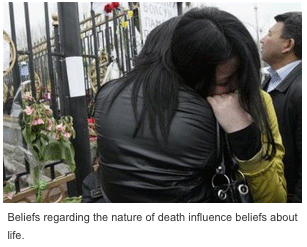
Of all beliefs; those regarding life and death may be the most powerful. Man lives with the awareness of his own mortality and the unknown nature of death. Buddhism provides a view of death that empowers life.
Views regarding the nature of death vary with cultural and religious beliefs, but generally fall into two categories: annihilation and permanence. Annihilation is the belief that life ceases to exist at the time of death; death is the finality. Permanence is the belief that, after death, life continues in a better place, exemplified by Christianity, where the soul of the deceased goes to heaven.
As the purpose of Buddhism is for people to become happy and empowered, both the concept of annihilation and permanence were seen to have limitations. Living by the belief of annihilation, may lead to anxiety, if a person believes that death is the end of life, while the belief of permanence may lead to a life of self attachment, believing that after death awaits a better place. An extreme example of this would be suicide bombers.
Buddhism believes that an individual’s life is fused with the life of the universe. A metaphor for this is an ocean wave. The wave represents an individual’s life, while the ocean represents the life of the universe. When a wave loses form, it returns to the ocean, at no time is the wave separate from the ocean.
When alive, an individual can take action to change his or her circumstance; it is an opportunity to change karma. In death, human life is latent, unable to take action. Sleep is a metaphor for death. While awake, action can be taken; during sleep, there is awareness but no action. Without action, karma cannot be changed. This is why Buddhism upholds life as the greatest gift. An individual’s karma will resume, as before death, upon reincarnation.
Soka Gakkai president, Daisaku Ikeda, writes: “Unless we are free of the suffering of death, we cannot savor true happiness. But liberating ourselves from this suffering cannot be achieved through theorizing or intellectualizing. Life and death make up the great, eternal rhythm of the universe itself. When we come to apprehend the greater self within us that is part of this rhythm-and feel in the depths of our being that this rhythm is the fundamental pulse sustaining our lives-we can overcome the suffering of death.”
Author : Andrew Silver
Source : http://www.examiner.com
The SGI Phoenix Culture Center offers Buddhism 101 meetings, providing visitors with an introduction to Buddhist practice. You can contact them at (602) 861-1313.




